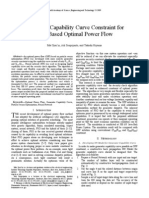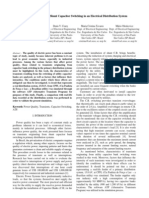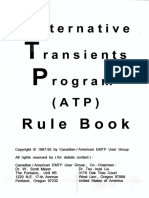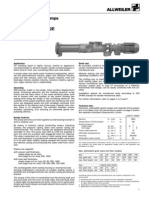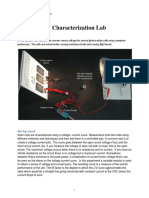Simulation of IEEE First Benchmark Model For SSR Studies
Uploaded by
PabloNalogowskiSimulation of IEEE First Benchmark Model For SSR Studies
Uploaded by
PabloNalogowskiIJSRD - International Journal for Scientific Research & Development| Vol.
1, Issue 3, 2013 | ISSN (online): 2321-0613
Simulation of IEEE FIRST BANCHMARK Model
for SSR Studies
K. G. Prajapati1 A. M. Upadhyay2
1
M. E. [Electrical] Student 2Associate Professor
1, 2
Department of Electrical Engineering
1, 2
S. S. E. C., Bhavnagar, Gujarat, India
AbstractThe benchmark model for the study of
Subsynchronous resonance is presented by IEEE
Subsynchronous Resonance task force. Here, the IEEE First
Benchmark system for Subsynchronous resonance is
simulated using MATLAB for comparison. The oscillations
due to SSR are observed between turbine-generator and
between various turbine shafts. This paper mainly focuses
on the use of highly versatile software MATLAB for
analysis of Subsynchronous Resonance in power systems.
Key words: SSR, Synchronous Machine, Transient torque,
Multimass model.
I. INTRODUCTION
Electrical power generation involves interaction between the
electrical and mechanical energies coupled through the
generator. It follows that any change in the electric power
system results in a corresponding reaction/response from the
mechanical system and vice versa. Slow-changing load
translates to a slow-changing mechanical torque on the rotor
shaft, which in turn, is matched by a slow-changing rotor
angle to new steady-state angle between the rotor and the
stator along with adjustment in the mechanical power input
to the rotor through the turbines. Major disturbances such as
faults and fault clearing result in large transient torques on
the mechanical system and corresponding transient twisting
of the rotor shaft couplings between tandem turbines and
generator [1].
Worldwide series capacitors have been extensively
used for improving power transmission. While it has been
known that series capacitors can cause self-excited
oscillations at low frequencies (due to low X/R ratio) or at
Subsynchronous frequencies (due to induction generator
effect), the problem of self excited torsional frequency
oscillations (due to torsional oscillations) was first
experienced at Mohave power station in U.S.A. in
December 1970 and October 1971 [2]. The problem of self
excitation due to torsional interaction is a serious problem
and led to detailed analysis and study.
disturbances. System disturbances cause sudden changes in
the network parameters, resulting in sudden changes in
currents that will tend to oscillate at the natural frequencies
of the network. Also, this can cause shaft damage as
experienced at Mohave generating station in U.S.A. [3].
Digital programs like Electromagnetic Transient Programs
(EMTP) and Simulator like RTDS (Real Time Digital
Simulator) are available to perform the studies of
Subsynchronous Resonance. SIMULINK, developed by
MathWorks, is a data flow graphical programming language
tool for modeling, simulating and analyzing multi domain
dynamic systems. With the use of above software, the First
Benchmark model[4] is developed and simulated.
III. THE IEEE FIRST BENCHMARK MODEL
The single line diagram of a Single Machine Infinite Bus
system given by IEEE committee for SSR study is shown in
fig. 1[4].
A
XT
B
R
XC
XL
Gen
Gap
XF
XSYS
Infinite
Bus
XF
Fig. 1: Single Line Diagram for First Benchmark Model for
SSR Study.
The circuit parameters are expressed in per unit on the
generator MVA rating at 60Hz. Reactances are proportional
to frequency, resistances are constant. The infinite bus is a
3-phase 60 Hz voltage source with zero impedance at all
frequencies. Two fault locations (A and B) are designated.
This network is used for both transient and self-excitation
studies.
II. TYPES OF SSR INTERACTIONS
IV. SYSTEM MODELING
There are three types of SSR interactions which are
Induction Generator Effect, Torsional Interaction Effect and
Transient Torque Effect.
Induction generator effect is caused by self excitation of
the electrical system. Torsional interaction occurs when the
induced subsynchronous torque in the generator is close to
one of the torsional natural modes of the turbine generator
shaft[3]. Transient torques are those that result from system
First, individual mathematical models describing the
synchronous generator, turbine-generator mechanical
system, and electrical network are presented. Then, all the
equations are combined in a standard form for the analysis.
A. Synchronous Machine Modeling
For SSR analysis, experience has shown that reasonable
results may be obtained by defining two rotor circuits on
All rights reserved by www.ijsrd.com
513
Simulation of IEEE FIRST BANCHMARK Model for SSR Studies
(IJSRD/Vol. 1/Issue 3/2013/0027)
two different axes that are in space quadrature - the familiar
d and q-axes. A conventional synchronous machine
schematic diagram is shown in Fig. 2. The model shows
three-phase armature windings on the stator (a, b, and c).
The rotor of the machine carries the field fd winding and
damper windings. The damper windings are represented by
equivalent damper circuits in the direct axis (d-axis) and
quadrature axis (q-axis): 1d on d-axis, and 1q and 2q on qaxis.
i
d - axis
The machine circuit equations given are usually expressed
schematically by the d and q equivalent circuits as shown in
Fig. 3
lF
rF
la
lD
uF
+
iF
+
vD
_
LAD
iD
rD
q - axis
(t)
- D +
lG
rG
i
e
la
iG
rQ
ec
Fig. 2 : Schematic diagram of a conventional synchronous
machine.
,b,c
: Stator windings
ea ,eb,ec
: Stator three-phase winding voltages.
: Field winding.
fed
: Field voltage.
1d
: d axis damper winding.
1q
: First q axis damper winding.
2q
: Second q axis damper winding.
][ ]
TLPA
T IP
H ,H
Two equivalent rotor circuits are represented in each axis of
the rotor - F and D in the d-axis, and G and Q in the q-axis,
with positive current direction defined as the direction
causing positive magnetization of the defined d- and q-axis
direction, respectively. Synchronous machine operation
under balanced three-phase conditions is of particular
interest for SSR analysis. The synchronous machine voltage
equations in normalized form can be written as follows.
Fig. 3 :Equivalent circuit of machine from the voltage
equations
THP
: The electrical angle (in rad) by which d axis
leads magnetic axis of phase a winding.
- Q +
The Synchronous Machine block is given in MATLAB
Simpowersystems Library. The model takes into account the
dynamics of the stator, field, and damper windings. The
equivalent circuit of the model is represented in the rotor
reference frame (qd frame). All parameters and electrical
quantities are viewed from the rotor.
: Stator three-phase winding currents.
fd
+
vQ
_
LAQ
iQ
(t)
iq
ra
lQ
eb
ia ,ib,ic
id
ra
HP
LPA
IP
KAI
KIH
DH
DI
TLPB
A ,A
I ,P
,
GEN
LPB
KGB
KBA
DA
TGEN
B ,B
DB
E ,E
EXC
KEG
DG
DE
Fig. 4: Mechanical structure of six mass FBM system
B. Multi-mass model of the Turbine - Generator Shaft
The turbine-generator mechanical system consists of six
masses; high-pressure turbine (HP), intermediate-pressure
turbine (IP), low pressure turbine A (LPA) and low pressure
turbine B (LPB), an exciter (EXC), and a generator (GEN)
coupled to a common shaft as shown in Fig.4. The turbine
masses, generator rotor and exciter are considered as lumped
masses (rigid body) connected to each other via massless
springs.
From Fig.4, the torques acting on the generator mass are:
Generator:
Input torque
Output torque
Damping
All rights reserved by www.ijsrd.com
514
Simulation of IEEE FIRST BANCHMARK Model for SSR Studies
(IJSRD/Vol. 1/Issue 3/2013/0027)
Similarly, for the low pressure turbine B, the forces acting
are:
Low pressure turbine B:
multimass turbine.
The torque on the shaft between the LPA-LPB
turbine masses is shown in fig.5(d). There are oscillations of
frequency warring from 15Hz to 45Hz (subsynchronous).
Input torque
Output
Damping
Similarly all other masses torque equations can be derived.
The Steam Turbine and Governor block in MATLAB
Simpower systems library implements a complete tandemcompound steam prime mover, including a speed governing
system, a four-stage steam turbine, and a shaft with up to
four masses. The shaft models a four-mass system, which is
coupled to the mass in the Synchronous Machine model for
a total of five masses. The exciter mass is omitted and a
static excitation system is used. Machine's mass is labeled as
mass #2. The mass in the Steam Turbine and Governor
block, which is closest to the machine's mass, is mass #3,
while the mass farthest from the machine is mass #6. The
shaft is characterized by mass inertias H, damping factors D,
and rigidity coefficients K.
V. SIMULATIONS AND RESULTS
The MATLAB Simpowersystems library components such
as multimass model of steam turbine and governor system,
Synchronous machine, exciter, a lumped parameter
transmission line and infinite source are connected as in
fig.1. and the circuit model is prepared in MATLAB
SIMULINK. The system is simulated for the same
operating condition as in[4]. For the transient case, three
phase fault is applied at bus B in fig.1 for duration of 75
msec from 0.01 seconds to 0.075 seconds(4.5 cycles). Fault
reactance is 0.04 p.u. and it is adjusted to produce a
capacitor transient voltage approaching the lower gap
setting.
Generator power output Po
0.9 pu
Generator power factorPF
0.9 pu (lagging)
Capacitor reactance
0.371 pu
Capacitor bypass voltage
(not used)
Capacitor reinsertion voltage
(not used)
Table. 1: Transient Case Description
Capacitor voltage, Generator current, Generator Electrical
Torque and Shaft Torque of LPA-LPB are plotted for the
time duration of 0.5 sec.
Fig.5(a).shows the variation of voltage across the
capacitor in per unit. The Capacitor voltage is varying up to
1 p.u. and it is settling down to a constant value after 0.3
seconds. Fig.5(b). shows the variation of the machine
current of phase A in per unit. From the graph, it is seen that
the machine phase current is oscillatory. Electrical torque of
the synchronous generator is shown Fig.5(c). It is clear that
the torque is not constant after application of fault at bus B.
That shows the electrical transmission network resonant
frequency matches one of the natural modes of the
Fig. 5: Response Curves For Transient Case
Extending the simulation for 5 seconds for the same
operating condition and applying three phase fault at bus-B
in fig.1 after 50 cycles and clearing after 4.5 cycles the
torque oscillations are as shown in fig.6. The oscillations are
growing rapidly. Fig.7 is FFT analysis window of the torque
on the shaft section LPA-LPB. It is clear from the fig. that
three torsional modes 16 Hz, 25 Hz, and 32 Hz are excited.
VI. CONCLUSION
By exciting the turbine torsional modes with three phase
fault Subsynchronous Resonance Phenomena is simulated.
The simulation is carried out for the same operating
condition as in [4]. Comparing with the reference results
except for the self-excitation case, the results obtained
(fig.5) are closely matching. The results are slight different
because of the difference in modeling of the components
and method of solving the non-linear equations. Also with
the FFT analysis tool of Power GUI the excited torsional
modes can be observed. The MATLAB model for SSR can
All rights reserved by www.ijsrd.com
515
Simulation of IEEE FIRST BANCHMARK Model for SSR Studies
(IJSRD/Vol. 1/Issue 3/2013/0027)
be used for the analysis of the various strategies of SSR
mitigation.
C. Transformer Parameters:
Rated MVA: 892.4
Voltage Rating: 26/539 kV
Delta / Star grounded
R = 0.00792 pu
X = 0.14 pu
X0 = 0.14 pu
D. Transmission line parameters:
R = 0.02 pu
X = 0.50 pu
E. Series capacitor:
C = 0.371 pu
F. Infinite Bus
Voltage: 500 kV RMS L-L
Phase angle: 0
G. Fault Impedance
Reactance: 0.04 pu
REFERENCES
Fig. 7: FFT Analysis Of The LPA-LPB Section Torque Shown
In Fig. 6
APPENDIX
The network parameters of the system are as follows:
A. Generator Parameters
Power Factor: 0.9 lagging
Xa = 0.13 pu
Xd = 1.79 pu
Xd= 0.169 pu
Xl = 0.135 pu
Xq = 1.71 pu
Xq= 0.228 pu
Xq
pu
Ra=0.002 pu
Td0 = 4.3 s
Td0 = 0.032 s
Tq0
Tq0
B. Mechanical Parameters:
Mass
Inertia(Seconds)
Torque Fraction
HP
0.0929
0.30
IP
0.1556
0.26
LPA
0.8587
0.22
LPB
0.8842
0.22
GEN
0.8686
Shaft
Spring Constant (pu)
HP - IP
7277
IP - LPA
13168
LPA-LPB
19618
LPB-GEN
26713
[1] N. G. Hingorani, L. Gyugyi, Understanding
FACTS: concepts and technology of flexible AC
transmission systems, New York: IEEE Press, 2000.
[2] K.R. Padiyar, Power System Dynamics Stability and
Control, Indian Institute of Science, Bangalore, 1996.
[3] P.M.
Anderson,
B.L.
Agrawal,
J.E.
Van
Ness,Subsynchronous
Resonance
in
Power
Systems, IEEE Press, New York, 1990.
[4] IEEE SSR Working Group, First Benchmark Model
for Computer Simulation of Subsynchronous
Resonance, IEEE Transactions on Power Apparatus
and Systems, Vol. PAS-96, no. 5, September/October
1977.
[5] IEEE Committee Report, Rearers Guide To
Subsynchronous
Resonance,
Subsynchronous
Resonance Working Group of the System Dynamic
Performance Subcommittee, IEEE Transactions on
Power Systems. Vol. 7, No. 1, February 1992
[6] MATLAB and SIMULINK Demos and Documentation.
[Online]. Available: http:// www.mathworks.com/
access/ helpdesk/ help/techdoc/
All rights reserved by www.ijsrd.com
516
You might also like
- (Boldea) - The Induction Machines Design Handbook, Second Edition-Trang-456-482 PDFNo ratings yet(Boldea) - The Induction Machines Design Handbook, Second Edition-Trang-456-482 PDF27 pages
- Pulsewidth Modulation For Electronic Power Conversion: J. Holtz, Fellow, IEEE Wuppertal University - Germany100% (1)Pulsewidth Modulation For Electronic Power Conversion: J. Holtz, Fellow, IEEE Wuppertal University - Germany18 pages
- An Investigation Into The Capabilities of MATLAB Power System Toolbox For Small Signal Stability Analysis in Power SystemsNo ratings yetAn Investigation Into The Capabilities of MATLAB Power System Toolbox For Small Signal Stability Analysis in Power Systems7 pages
- Synchronous Generator Modeling Using MatlabNo ratings yetSynchronous Generator Modeling Using Matlab6 pages
- Simulation of Some Power System, Control System and Power Electronics Case Studies Using Matlab and PowerWorld SimulatorFrom EverandSimulation of Some Power System, Control System and Power Electronics Case Studies Using Matlab and PowerWorld SimulatorNo ratings yet
- Static Synchronous Series Compensator Using ANo ratings yetStatic Synchronous Series Compensator Using A4 pages
- A Simple Method To Determine Double-Cage Rotor Equivalent Circuit Parameters of Induction Motors From No-Load and Locked-Rotor TestsNo ratings yetA Simple Method To Determine Double-Cage Rotor Equivalent Circuit Parameters of Induction Motors From No-Load and Locked-Rotor Tests10 pages
- A New Stray-Load Loss Formula For Small and Medium-Sized Induction MotorsNo ratings yetA New Stray-Load Loss Formula For Small and Medium-Sized Induction Motors7 pages
- A Low Order System Frequency Response ModelNo ratings yetA Low Order System Frequency Response Model10 pages
- Nterharmonics in Ower Ystems: IEEE Interharmonic Task Force, Cigré 36.05/CIRED 2 CC02 Voltage Quality Working GroupNo ratings yetNterharmonics in Ower Ystems: IEEE Interharmonic Task Force, Cigré 36.05/CIRED 2 CC02 Voltage Quality Working Group9 pages
- Swnm20 en Pss Netomac Graphical Model Builder s4No ratings yetSwnm20 en Pss Netomac Graphical Model Builder s42 pages
- ECE 8830 - Electric Drives: Topic 16: Control of SPM Synchronous Motor DrivesNo ratings yetECE 8830 - Electric Drives: Topic 16: Control of SPM Synchronous Motor Drives59 pages
- A New Start-Up Method For A Load Commutated Inverter For Large Synchronous Generator of Gas-TurbineNo ratings yetA New Start-Up Method For A Load Commutated Inverter For Large Synchronous Generator of Gas-Turbine10 pages
- Digsilent Powerfactory: Technical Reference DocumentationNo ratings yetDigsilent Powerfactory: Technical Reference Documentation19 pages
- Damping Torsional Interharmonic Effects of Large Drives: IEEE Transactions On Power Electronics May 2010No ratings yetDamping Torsional Interharmonic Effects of Large Drives: IEEE Transactions On Power Electronics May 201010 pages
- Transient Theory of Synchronous Generator Under Unbalanced ConditionsNo ratings yetTransient Theory of Synchronous Generator Under Unbalanced Conditions17 pages
- Capacitor Placement in Unbalanced Power SystemsNo ratings yetCapacitor Placement in Unbalanced Power Systems6 pages
- Mitra - Technical Guide On Composite Load ModelingNo ratings yetMitra - Technical Guide On Composite Load Modeling80 pages
- Generator Capability Curve Constraint For PSO Based Optimal Power Flow100% (1)Generator Capability Curve Constraint For PSO Based Optimal Power Flow6 pages
- Lecture 10: Field-Oriented Control: ELEC-E8405 Electric Drives (5 ECTS)No ratings yetLecture 10: Field-Oriented Control: ELEC-E8405 Electric Drives (5 ECTS)22 pages
- AGN 124 - AVR Power Supplies: Application Guidance Notes: Technical Information From Cummins Generator TechnologiesNo ratings yetAGN 124 - AVR Power Supplies: Application Guidance Notes: Technical Information From Cummins Generator Technologies11 pages
- Iec Standard: IEC 61089 - OVERHEAD CONDUCTOR-e.pdf IEC61089-amd1 PDFNo ratings yetIec Standard: IEC 61089 - OVERHEAD CONDUCTOR-e.pdf IEC61089-amd1 PDF2 pages
- Model Acceptance Test Guideline Nov 2021No ratings yetModel Acceptance Test Guideline Nov 202171 pages
- An ATP Simulation of Shunt Capacitor Switching in An Electrical Distribution SystemNo ratings yetAn ATP Simulation of Shunt Capacitor Switching in An Electrical Distribution System7 pages
- Genadvisor Partial Discharge Monitoring: Generator ServiceNo ratings yetGenadvisor Partial Discharge Monitoring: Generator Service2 pages
- Failure Risk Analysis Under Switching Surges in Power Transmission SystemsNo ratings yetFailure Risk Analysis Under Switching Surges in Power Transmission Systems9 pages
- Presentation On DVR, JS Saroya, CS Singh, 03.12.11No ratings yetPresentation On DVR, JS Saroya, CS Singh, 03.12.1175 pages
- NERC Modeling Notification - Gas Turbine Governor ModelingNo ratings yetNERC Modeling Notification - Gas Turbine Governor Modeling7 pages
- A Case Study for a Single-Phase Inverter Photovoltaic System of a Three-Bedroom Apartment Located in Alexandria, Egypt: building industry, #0From EverandA Case Study for a Single-Phase Inverter Photovoltaic System of a Three-Bedroom Apartment Located in Alexandria, Egypt: building industry, #0No ratings yet
- A Unified Method For Modeling and Simulation of Three Phase Induction Motor DrivesNo ratings yetA Unified Method For Modeling and Simulation of Three Phase Induction Motor Drives5 pages
- Transient Stability Analysis of Power System Using MatlabNo ratings yetTransient Stability Analysis of Power System Using Matlab5 pages
- Calculation of Total Current Harmonic Distortion by PWM Method For Permanent Magnet Synchronous MotorsNo ratings yetCalculation of Total Current Harmonic Distortion by PWM Method For Permanent Magnet Synchronous Motors4 pages
- Steady State Analysis of Induction Generator Infinite Bus SystemsNo ratings yetSteady State Analysis of Induction Generator Infinite Bus Systems21 pages
- 159 166 - 24 - PDF 2024 Jun 07 15 31 59No ratings yet159 166 - 24 - PDF 2024 Jun 07 15 31 5917 pages
- FastReport Studio Command-Line Manual (En)No ratings yetFastReport Studio Command-Line Manual (En)6 pages
- Process Flow of New Implementation in SAP at OEM: Created by RUSHI SONINo ratings yetProcess Flow of New Implementation in SAP at OEM: Created by RUSHI SONI62 pages
- M04 - Programming in Matlab - XXXX - CH04No ratings yetM04 - Programming in Matlab - XXXX - CH0423 pages
- Design a lexical analyser for given language and the lexical analyser should ignore redundant spacesNo ratings yetDesign a lexical analyser for given language and the lexical analyser should ignore redundant spaces7 pages
- Complex Analysis - George Cain - Georgia Institute of TechnologyNo ratings yetComplex Analysis - George Cain - Georgia Institute of Technology115 pages
- (Boldea) - The Induction Machines Design Handbook, Second Edition-Trang-456-482 PDF(Boldea) - The Induction Machines Design Handbook, Second Edition-Trang-456-482 PDF
- Pulsewidth Modulation For Electronic Power Conversion: J. Holtz, Fellow, IEEE Wuppertal University - GermanyPulsewidth Modulation For Electronic Power Conversion: J. Holtz, Fellow, IEEE Wuppertal University - Germany
- An Investigation Into The Capabilities of MATLAB Power System Toolbox For Small Signal Stability Analysis in Power SystemsAn Investigation Into The Capabilities of MATLAB Power System Toolbox For Small Signal Stability Analysis in Power Systems
- Simulation of Some Power System, Control System and Power Electronics Case Studies Using Matlab and PowerWorld SimulatorFrom EverandSimulation of Some Power System, Control System and Power Electronics Case Studies Using Matlab and PowerWorld Simulator
- A Simple Method To Determine Double-Cage Rotor Equivalent Circuit Parameters of Induction Motors From No-Load and Locked-Rotor TestsA Simple Method To Determine Double-Cage Rotor Equivalent Circuit Parameters of Induction Motors From No-Load and Locked-Rotor Tests
- A New Stray-Load Loss Formula For Small and Medium-Sized Induction MotorsA New Stray-Load Loss Formula For Small and Medium-Sized Induction Motors
- Nterharmonics in Ower Ystems: IEEE Interharmonic Task Force, Cigré 36.05/CIRED 2 CC02 Voltage Quality Working GroupNterharmonics in Ower Ystems: IEEE Interharmonic Task Force, Cigré 36.05/CIRED 2 CC02 Voltage Quality Working Group
- ECE 8830 - Electric Drives: Topic 16: Control of SPM Synchronous Motor DrivesECE 8830 - Electric Drives: Topic 16: Control of SPM Synchronous Motor Drives
- A New Start-Up Method For A Load Commutated Inverter For Large Synchronous Generator of Gas-TurbineA New Start-Up Method For A Load Commutated Inverter For Large Synchronous Generator of Gas-Turbine
- Digsilent Powerfactory: Technical Reference DocumentationDigsilent Powerfactory: Technical Reference Documentation
- Damping Torsional Interharmonic Effects of Large Drives: IEEE Transactions On Power Electronics May 2010Damping Torsional Interharmonic Effects of Large Drives: IEEE Transactions On Power Electronics May 2010
- Transient Theory of Synchronous Generator Under Unbalanced ConditionsTransient Theory of Synchronous Generator Under Unbalanced Conditions
- Mitra - Technical Guide On Composite Load ModelingMitra - Technical Guide On Composite Load Modeling
- Generator Capability Curve Constraint For PSO Based Optimal Power FlowGenerator Capability Curve Constraint For PSO Based Optimal Power Flow
- Lecture 10: Field-Oriented Control: ELEC-E8405 Electric Drives (5 ECTS)Lecture 10: Field-Oriented Control: ELEC-E8405 Electric Drives (5 ECTS)
- AGN 124 - AVR Power Supplies: Application Guidance Notes: Technical Information From Cummins Generator TechnologiesAGN 124 - AVR Power Supplies: Application Guidance Notes: Technical Information From Cummins Generator Technologies
- Iec Standard: IEC 61089 - OVERHEAD CONDUCTOR-e.pdf IEC61089-amd1 PDFIec Standard: IEC 61089 - OVERHEAD CONDUCTOR-e.pdf IEC61089-amd1 PDF
- An ATP Simulation of Shunt Capacitor Switching in An Electrical Distribution SystemAn ATP Simulation of Shunt Capacitor Switching in An Electrical Distribution System
- Genadvisor Partial Discharge Monitoring: Generator ServiceGenadvisor Partial Discharge Monitoring: Generator Service
- Failure Risk Analysis Under Switching Surges in Power Transmission SystemsFailure Risk Analysis Under Switching Surges in Power Transmission Systems
- Presentation On DVR, JS Saroya, CS Singh, 03.12.11Presentation On DVR, JS Saroya, CS Singh, 03.12.11
- NERC Modeling Notification - Gas Turbine Governor ModelingNERC Modeling Notification - Gas Turbine Governor Modeling
- Computer Aided Design of Electrical MachinesFrom EverandComputer Aided Design of Electrical Machines
- A Case Study for a Single-Phase Inverter Photovoltaic System of a Three-Bedroom Apartment Located in Alexandria, Egypt: building industry, #0From EverandA Case Study for a Single-Phase Inverter Photovoltaic System of a Three-Bedroom Apartment Located in Alexandria, Egypt: building industry, #0
- A Unified Method For Modeling and Simulation of Three Phase Induction Motor DrivesA Unified Method For Modeling and Simulation of Three Phase Induction Motor Drives
- Transient Stability Analysis of Power System Using MatlabTransient Stability Analysis of Power System Using Matlab
- Calculation of Total Current Harmonic Distortion by PWM Method For Permanent Magnet Synchronous MotorsCalculation of Total Current Harmonic Distortion by PWM Method For Permanent Magnet Synchronous Motors
- Steady State Analysis of Induction Generator Infinite Bus SystemsSteady State Analysis of Induction Generator Infinite Bus Systems
- Process Flow of New Implementation in SAP at OEM: Created by RUSHI SONIProcess Flow of New Implementation in SAP at OEM: Created by RUSHI SONI
- Design a lexical analyser for given language and the lexical analyser should ignore redundant spacesDesign a lexical analyser for given language and the lexical analyser should ignore redundant spaces
- Complex Analysis - George Cain - Georgia Institute of TechnologyComplex Analysis - George Cain - Georgia Institute of Technology































